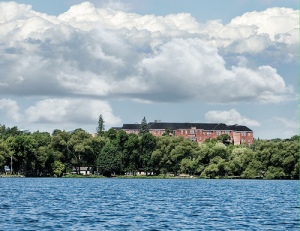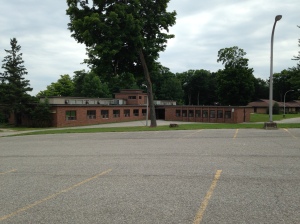This post was written by student engagement facilitator, Kim Collins.
“Welcome.”
“To start your experience, please help yourself to coffee, tea and muffins,” bubbles the animated woman in the bright purple t-shirt as she points to the breakfast spread laid out before us. She adjusts her headset and I half expect her ask for another size as if she is a retail assistant at the Gap.
It’s hard to reconcile this cheery greeting with building I am standing in. Even harder to reconcile the idyllic setting in which this building is placed. I am at Huronia Regional Centre in Orillia. From the outside, the building could be an ivy league school. The red brick, white details, the wind blowing through the pines and deciduous trees that fill the acres of lush greenery, down to the sparkling blue of Lake Simcoe. It’s beautiful, or at least it should be.

I have come to Huronia on one of the six visitations weekends which were stipulated in the class action settlement by survivors of this institution. My fellow visitors and I are provided with a government tour guide (the bubbly woman in purple) and a security guard. We are lucky enough to have on our tour, two survivors Pat and Marie and Marilyn a litigation guardian who worked at Huronia and whose brother died here.
As we walk into the bowels of the institution we are told the stories of what it was like to be imprisoned here. The horrifying details cling to me like the stench of the place.
If you read the Government of Ontario’s website about Huronia you will read that, ‘residents’ ‘participated’ in ‘vocational’ training programs. That’s part of what feels so wrong in this idyllic setting; the language. We are taken through ‘cottages’ which are not cottages, but prisons. We are shown the ‘play room’ in which punishment, not play took place. The ‘vocational’ training areas are houses of forced, unpaid labour. The list and the grounds are endless. We walk for hours through dilapidated and crumbling buildings, through tunnels, long corridors, and wards, the ever present locked door a feature of every room in every building. It is overwhelming.




We come to the former gym which is now used as a training area for the Ontario Provincal Police. The far end of the gym is littered with mannequins, posters and equipment all to train officers how to tase and subdue offenders. As a group we cannot help but think how many times those ‘offenders’ are disabled people. The irony and the offense of this is clearly lost on the OPP.
Exhausted and overwrought we emerge at the end of the visitation near the admissions centre. Marilyn comes over to answer a question I had asked earlier in the day. I had wanted to know if there was a morgue on the property and there was; it was housed under the admission centre. Survivors have stated that they were told they would die there, that there was no way to escape Huronia. You came and you left through the same building.

Across the road from the institution is the Huronia Regional Centre Cemetery. There are over 2,000 people buried there. Only 571 of those graves are marked, many only with their patient number. The markers that remain are crowded next to one another. Even in death, there was no space. Many markers were moved, stolen, to be used as paving stones for nearby houses. Those that have been returned are cemented together. Our last moments here are communal. We sing together around the collected grave markers. Our voices combined and raised I feel a sense of hope, of purpose.

Gonna keep on moving forward ,
Keep on moving forward,
Keep on moving forward
Never turning back , Never turning back
Gonna keep on moving proudly… Gonna keep on singing loudly… Gonna keep on loving boldly… Gonna keep on moving forward… (Pat Humphries, 1984)
How could anyone ever tell you, you were anything less than beautiful?
How could anyone ever tell you, you were less than whole?
How could anyone fail to notice, that your loving is a miracle?
How deeply you’re connected to my soul. (Libby Roderick, http://www.libbyroderick.com)
Before the trip to Huronia, I met Pat, Marie and Marilyn at Ryerson University. At the end of their talk Pat asked us to be their union; to take up their story. During those moments of song I felt how closely we are all connected and how important it is for us to support people to tell their stories.
It’s easy to think that these stories aren’t needed, that Huronia is closed, this horrible chapter in Ontario’s history has ended. Sadly, this is far from the truth. Disabled people are still housed in group homes, they are still denied access to education, to services, to employment, like the buildings of Huronia, the list is endless. Public figures like Doug Ford still question if disabled people should be allowed out from behind closed doors. Huronia may be closed, but attitudes have not changed. So together we need to keep on moving forward, keep on moving proudly, keep on signing loudly, keep on loving boldly, never turning back.